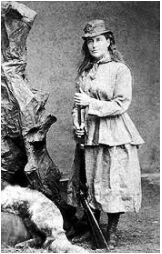
Martha Maxwell
1831 – May 1881Martha Maxwell was born in Dartt’s Settlement in Tioga County, Pennsylvania. She gained a love of nature as a small girl while walking with her grandmother in the woods, listening as she identified different kinds of trees and animals. Martha had a goal to attend college and expand her education, but she knew she would have to work hard, as her family had little money. She attended Oberlin College in Ohio, until her money ran out. She returned home to teach, where she met her future husband, James Maxwell. He gave her the financial support to finish her education at Lawrence College in Wisconsin. The pair moved to Colorado during the first wave of the Pike’s Peak Gold Rush, hoping to strike it rich. Once there, they moved into a one room house they had bought on the prairie, only to find a German claim jumper had moved into the building. She unhinged the door and found inside her house hundreds of animals that had been preserved and stuffed by the German taxidermist.
This piqued Martha’s own interest in taxidermy, and after reading a how-to book, she taught herself how to preserve the animals. Martha spent a great deal of time camping and hunting in the Colorado wilderness, which earned her the nickname “Colorado Huntress.”. Her daughter, Mabel, once wrote, “Moving quietly she would crawl through the underbrush, over rocks, up mountains and down streams until she found her quarry. Then she would stand, silent as a tree, watching the birds and animals.” Over the years, she built an extensive collection of over 600 animals ranging from birds to bison to pronghorn antelope. She pioneered techniques in preserving their skins and making models of the animals, and was the first taxidermist to display her specimens on a background of their natural habitat.
In the fall of 1868, approximately 100 of her specimens were put on display at an exhibit of the Colorado Agricultural Society. Martha opened her own museum, the Rocky Mountain Museum, in Boulder Colorado in 1874. The museum displayed her specimens, stuffed and mounted in their natural settings. Her museum was the first to classify animals according to their habitat. Martha was chosen to represent the Colorado Territory at the 1876 Philadelphia Centennial Exposition. She took with her dozens of stuffed animals and birds that she had mounted in lifelike poses.
Martha preferred to be called a naturalist. She did not enjoy killing animals, but believed that studying animals is important to their survival. Many of her specimens were sent to the Smithsonian Museum for classification, and in her honor the Rocky Mountain Screech Owl (Scops Asio Maxwellae) was named after her.
